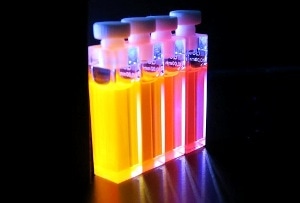May 17 2017
 Fluorescence of the conjugated polymers in solution. (copyright 2017 Hubert Piwonski)
Fluorescence of the conjugated polymers in solution. (copyright 2017 Hubert Piwonski)
KAUST researchers1 have come up with a strategy to create extremely fluorescent nanoparticles through meticulous molecular design of conjugated polymers. These types of miniature polymer-based particles could act as substitutes to conventional organic dyes and inorganic semiconductor quantum dots as fluorescent tags used in medical imaging.
Conjugated polymer-derived nanoparticles, referred to as Pdots, are thought to be capable of transforming several areas, including bio-sensing, bio-imaging, optoelectronics, and nanomedicine, because of their high stability under exposure to light, strong fluorescence, and low cytotoxicity. Their spectroscopic properties are tunable by alteration the polymer structures. This makes it important to deliberate on their design at the molecular level.
Bio-imaging applications require nanoparticles sufficiently small to be eliminated from the body and strongly discharge light in the far-red to near-infrared range. However, existing design and fabrication of Pdots have typically relied on empirical approaches, deterring attempts to fabricate these ultra-small nanoparticles.
To handle this challenge, Dr. Hubert Piwoński and Associate Professor Satoshi Habuchi formulated a systematic technique that improves the performance of Pdots. Habuchi explained that his team aimed to develop Pdots of brighter fluorescence and a smaller size by using conjugated polymers, whose backbone of alternating multiple and single bonds enables π electrons to move freely all over the structure.
For the first time, the researchers chose twisted, rather than planar, conjugated polymers as building blocks to produce their Pdots. Presently available Pdots typically display lower fluorescence intensity compared to their precursors due to their complex inter- and intra-chain photophysical interactions within particles.
According to Habuchi, this attempt was a shot in the dark—his team started the project without actually knowing what the end result would be— but they were still astonished by the fluorescence behaviors of these Pdots compared to their formerly tested analogs.
Initial results indicate that the newly synthesized nanoparticles were the brightest and smallest Pdots reported thus far. “Therefore, we hypothesized that the twisted shape of the molecules is responsible for the very bright fluorescence due to the suppression of π–π interactions inside the particles,” explained Habuchi.
The researchers corroborated their hypothesis by all-inclusive photophysical and structural characterizations. “That was the most exciting moment of our project,” added Habuchi, noting that this demonstration has paved the way for the precise prediction of the fluorescence properties of Pdots.
“We are now trying to introduce functional groups into these Pdots for bioconjugation,” Habuchi continued. The team is also designing and producing near-infrared-emitting nanoparticles.
Reference
1. Piwoński, H., Michinobu, T. & Satoshi Habuchi, S. Controlling photophysical properties of ultrasmall conjugated polymer nanoparticles through polymer chain packing. Nature Communications 8, 15256 (2017).